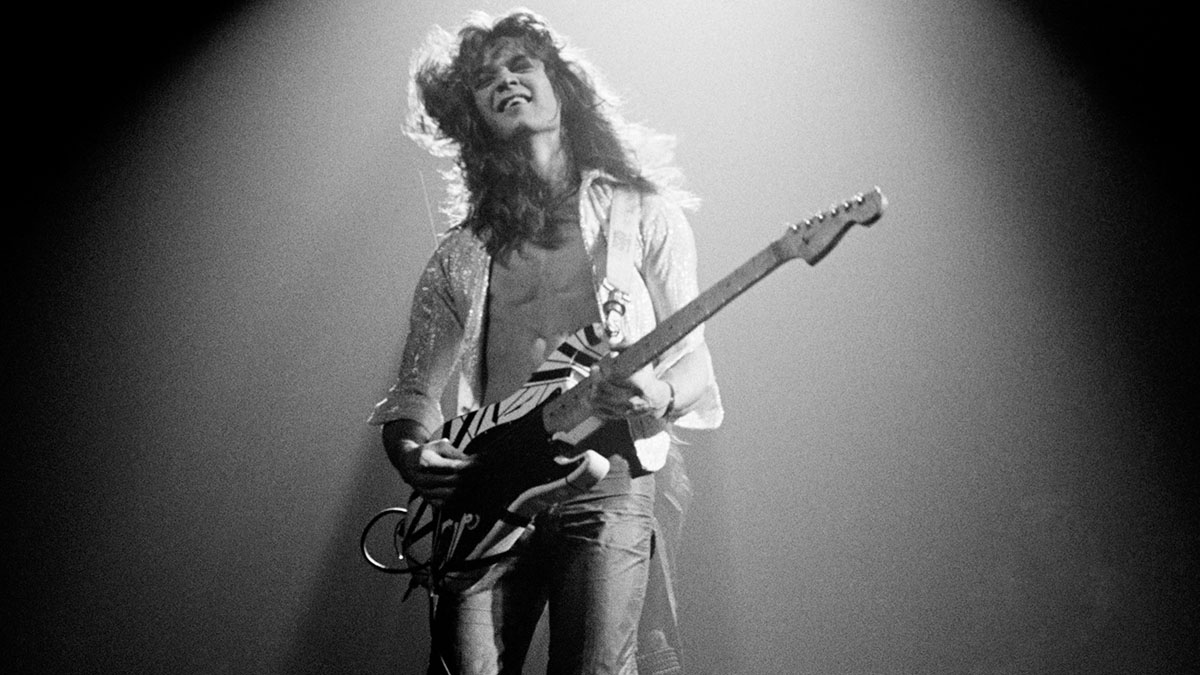The 50 greatest guitar effects moments of all time
As voted for by you, behold pedalboard genius from the likes of the Edge, Dimebag Darrell, Jimi Hendrix, Eddie Van Halen, Brian May and many more besides...
10. Prince – Purple Rain
EFFECT: Chorus
The unmistakeable intro to Prince’s 1984 signature ballad was actually played by guitarist Wendy Melvoin. Her first chord – that unusual Bbadd9/D – adds identity to the Bb/Gm11/F/EbAdd9 progression, but it’s that shimmering chorus (the exact model used is lost to time) that imbues the part with tonal depth and quavering poignancy.
9. Dire Straits – Money for Nothing
EFFECTS: Distortion, Filter
The recording involved a serendipitously misplaced mic, but the core sound is a wah pedal in a fixed position. You’ll find the sweet spot near the middle of its travel, where it creates a smoky sound with cool overtones. In a pinch, you can get close-ish by backing off your tone control.
8. Nirvana – Come As You Are
EFFECT: Chorus
Kurt’s favoured EHX Small Clone sounds distinctive, and not every chorus pedal will get close. He always used the depth switch in the up (stronger) position, with the rate around 11 o’clock. It’s a strong effect: if you have delay time or mix controls, wind them up.
7. The Rolling Stones – (I Can’t Get No) Satisfaction
EFFECT: Fuzz
All the latest guitar news, interviews, lessons, reviews, deals and more, direct to your inbox!
Credited as the first hit single to use a fuzz pedal, Satisfaction’s riff was meant for a horn section – the fuzz was only intended for a horn-like tone on Keef’s demo. His Maestro FZ-1 had a honky tone, so try boosting mids with an EQ if necessary.
6. Rage Against The Machine – Killing in the Name
EFFECT: Whammy
Tom Morello’s Whammy shifts the pitch up two octaves when the pedal is depressed. If you’ve got a mix control, set it to 100%.
From there, he moves his foot in time on the pedal, so the pitch goes up on the beat and returns to normal on the offbeat.
5. The Jimi Hendrix Experience – Purple Haze
EFFECT: Octave Fuzz
Octavias, and other analogue octave-up pedals, work best when they are hearing fundamental notes from your guitar, not harmonics. To get the clearest sound, use your neck pickup and back the tone off. The octave up will counteract this muddy tone. Digital octavers are cleaner but sound wrong here.
4. U2 – Where the Streets Have No Name
EFFECT: Delay
“The biggest difference between me and other players is that I don’t use effects to colour my parts. I create guitar parts using effects,” The Edge told TG in 2005. Taking Brian May’s delay concept to extremes, he created a cascade of notes from simple parts.
The core Edge sound is a dotted-eighth delay. If your delay has a tap tempo and a dotted eighth mode, select that and tap on the beat. If not, you can set your pedal to 357ms, which will be correct at the studio version’s tempo of 126bpm.
Add a small amount of modulation to the repeats if possible, set feedback to two repeats, and mix to around 70%. The exact length of Edge’s second delay is still controversial. Quarter notes (476ms) are OK, but 9/32nds (536ms) with 50% mix sound closer. Pan the first delay right and this one left.
3. Van Halen – Eruption
EFFECTS: Flanger, Phaser, Delay
Ed’s instrumental showpiece from Van Halen featured numerous rapid-fire licks with Ed playing the same pattern over and over. The phaser gave development to those licks, because its gradual sweep made the sound evolve with each repetition. It’s there from the start, but you hear it most clearly in the outro tapping section.
The filtering effect is part of why many listeners were fooled into thinking they were hearing a synthesiser. Ed favoured the Phase 90 because it pushed the mid frequencies, providing a slight lift for solos.
“I did that in the early days because it would make the solo pop,” he told Guitar World in 2015. “Suddenly it became a different sound, which helped me stand out in the mix, because in the club days, we usually had lousy P.A. systems and lousy sound guys!”
2. Van Halen – Ain’t Talkin’ ‘Bout Love
Effects: Flanger, Phaser, Delay
Much ink has been spilled on Eddie Van Halen’s paradigm-shifting distortion tone. His use of pedals was just as unique and important to the music. Ed’s early 'board had three effects: the MXR MX-117 Flanger, MXR Phase 90, and Echoplex EP-3 tape delay (in that order). All three are essential to Ain’t Talkin’ ‘Bout Love, a classic track from Van Halen’s self-titled first album.
You hear the EP-3 first, as the intro notes bounce off each other. Set your delay to a tape mode with a delay time of about 300ms. Contrary to conventional wisdom that delay should follow distortion, the EP-3 came before the input on Ed’s Marshall (so put your delay before any distortion or amp models).
The ‘echo volume’ (mix) control was relatively low, making the repeats sound cleaner than the direct guitar but not much quieter because of amp compression – you can’t get this sound with delay in the FX loop. You have to keep the feedback low to avoid a mush; try one or maybe two repeats. The delay plays an integral role in the main riff, creating that ‘skip’ in chords.

Ed kicked the flanger in and out just to emphasise the C-B-C single notes in the riff. He set the Manual (AKA delay time), Width and Speed knobs to around 11 o’clock, and wound the Regen (aka feedback) up to 2. He repeated this trick of highlighting parts of a riff with the flanger on Unchained (from 1981 album Fair Warning), that time maxing the Regen control.
All the solos on Van Halen got a kick from the Phase 90, a phaser with one knob for rate. Ed set it at between 9 and 10 o’clock. On Ain’t Talkin’ ‘Bout Love, the phased solo is doubled with an electric sitar. The Phase 90 sound is hard to replicate with other circuits, but here are things you can try: some phasers let you select the number of ‘stages’ (notch filters) in the sound. If yours does, set it to 4.
Early Phase 90s didn’t have much resonance, so set that low, and keep depth/width near the middle. Most phaser users went for faster, more dramatic settings, and EVH appreciated the subtlety of a Phase 90 set low.
1. The Jimi Hendrix Experience – Voodoo Child (Slight Return)
EFFECT: Wah
It’s difficult for listeners born post-1970 to grasp how monumental this moment was, because we’ve grown up surrounded by Hendrixisms.
Most of us can’t pinpoint exactly when we first heard a wah-wah. Hendrix’s whammy bar freakout at the end of Voodoo Child sounds spectacular now – in 1970, it sounded like the work of someone who literally could chop down mountains with the edge of his hand.
On Voodoo Child, Hendrix demonstrated that the wah pedal is not merely a tone modifier, but a musical instrument. Playing guitar-plus-wah is a different skill from playing guitar alone. It requires new co-ordination, and offers new expressive possibilities in return.
Like any newly invented instrument, there were no how-to guides available for guitar-plus-wah. Sure, the inventors had an idea of how it would be used, but it was down to musicians to discover and exploit the creative potential. Jimi wasn’t the first or only wah pioneer (he bought his wah after watching Frank Zappa), but he mined its possibilities so thoroughly that his playing still provides the manual 50 years later.
There are two principal ways to use the wah: you can rock your foot in time, providing rhythmic emphasis, or you can use the wah expressively, giving each note the right tone quality and emphasis. Jimi mastered both. Voodoo Chile opens with muted rhythmic strumming, with the wah rocking forward on each beat. Because the guitar riff is syncopated, the last note of the second bar lands when the wah is back, and swells as the pedal travels forward. This scratching inspired Isaac Hayes’ Theme From Shaft and is central to the funk guitar toolkit.
Jimi used a Vox Clyde McCoy wah, but the pedal you use is less important than the expression you put in. As he goes into the solo, Hendrix demonstrates the second type of wah use, making the guitar sing. In particular, he exploited the wah’s ability to change the tone of a note after it has been played, recalling the way great vocalists manipulate the resonance of sustained notes. The pedal also allowed him to zero in on the precise frequency to create harmonic feedback, a trick not featured on the studio version but used triumphantly live.
Hendrix also exploded the distinction between the rhythmic and expressive varieties of wah. At 0:42 where he pumps the pedal in a triplet rhythm while gradually releasing a string bend. As he moves into 2:22, he repeats this triplet rhythm while mashing a chord, accentuated by Eddie Kramer’s mix panning it between the speakers. This was wah for both groove and emotion at the same time.
To nail Hendrix’s wah mastery, you’ll need to develop your limb independence. First of all, learn to tap a constant quarter note rhythm with your foot, regardless of what rhythm your hands play. It might help to start by vocalising the guitar part so you can work out which notes coincide with your foot taps.
Once this is second nature, you can try other rhythms, like Hendrix’s triplets. After you’ve developed that independence, accentuating particular notes for expression should feel relatively easy.
Total Guitar is one of Europe's biggest guitar magazines. With lessons to suit players of all levels, TG's world-class tuition is friendly, accessible and jargon-free, whether you want to brush up on your technique or improve your music theory knowledge. We also talk to the biggest names in the world of guitar – from interviews with all-time greats like Brian May and Eddie Van Halen to our behind the scenes Rig Tour features, we get you up close with the guitarists that matter to you.

